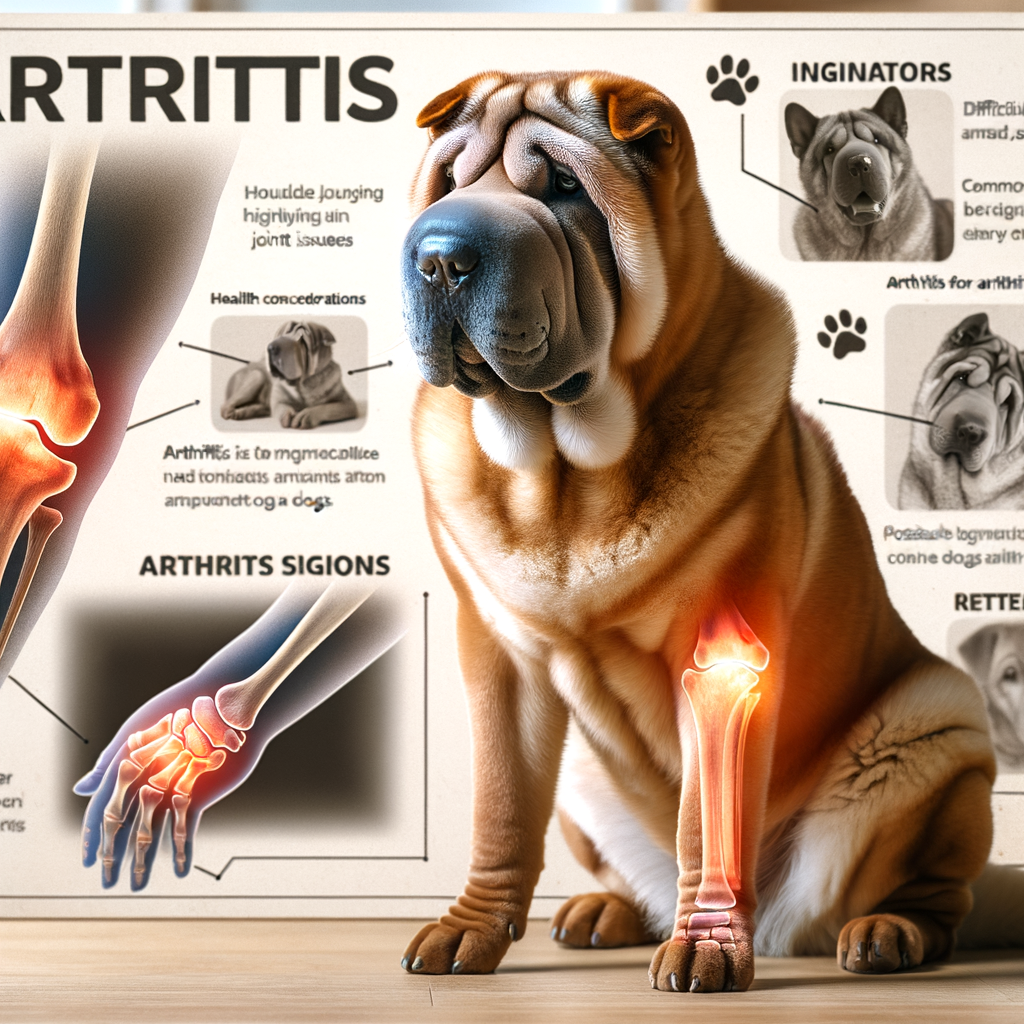
Introduction to Arthritis in Shar Peis
Arthritis is a common health issue that affects many dog breeds, including the Shar Pei. This breed, known for its distinctive wrinkled skin and blue-black tongue, is prone to several health issues, one of which is arthritis. In this article, we will delve into understanding the health issues of Shar Peis, focusing on joint problems and arthritis.
- Understanding Shar Pei Health Issues
- Common Shar Pei Joint Problems
- Overview of Arthritis in Shar Peis
Shar Peis are a robust and resilient breed, but they are not immune to health problems. They are prone to several health issues including skin disorders, eye problems, and joint issues. The breed’s unique physical characteristics, such as their loose skin and heavy bone structure, can contribute to these health concerns. It’s important for Shar Pei owners to be aware of these potential issues and monitor their pets closely for any signs of discomfort or distress.
One of the most common health problems in Shar Peis is joint issues. These can range from mild discomfort to severe pain and can significantly impact a dog’s quality of life. Hip and elbow dysplasia are common in this breed, both of which can lead to arthritis. These conditions occur when the joints do not develop properly, leading to pain and difficulty in movement. Regular vet check-ups can help detect these issues early and manage them effectively.
Arthritis in Shar Peis is a degenerative condition that affects the joints. It is characterized by inflammation and pain, and it can significantly impact a dog’s mobility and quality of life. The condition can develop as a result of wear and tear on the joints, or it can be a consequence of other health issues like hip or elbow dysplasia. Symptoms of arthritis in Shar Peis include limping, difficulty moving, and a decrease in activity levels. Early detection and treatment can help manage the symptoms and improve the dog’s quality of life.
In the following sections, we will delve deeper into recognizing arthritis symptoms in Shar Peis, discuss some case studies, and explore treatment options. By understanding this condition better, we can help our beloved Shar Peis live happier, healthier lives.
Recognizing Arthritis in Dogs
Arthritis is a common health issue in dogs, especially as they age. It’s crucial to recognize the signs early to help your pet manage the condition and maintain a good quality of life. Let’s explore the general signs of arthritis in dogs.
General Signs of Arthritis in Dogs
Arthritis can cause a variety of symptoms in dogs. Here are the three most common signs to watch out for:
- Changes in Behavior: Dogs suffering from arthritis may exhibit changes in their behavior. They may seem less interested in activities they once enjoyed, like playing fetch or going for walks. They might also become more irritable or aggressive due to the pain they’re experiencing.
- Difficulty Moving: Arthritis can make it difficult for dogs to move around. They might struggle to stand up or lie down, and they may limp or show stiffness, especially after resting. If your dog is having trouble with movements they could do easily before, it could be a sign of arthritis.
- Loss of Appetite: Pain and discomfort from arthritis can also affect a dog’s appetite. If your dog is eating less than usual or seems uninterested in food, it might be due to arthritis.
Remember, these signs can also be symptoms of other health issues, so it’s important to consult with a vet if you notice any changes in your dog’s behavior or physical condition. Early detection and treatment can make a significant difference in managing arthritis and ensuring your dog’s comfort and happiness.
Specific Arthritis Symptoms in Shar Peis
Arthritis can manifest in different ways in different breeds of dogs. In Shar Peis, a breed known for its distinctive wrinkly skin, arthritis symptoms can be particularly unique. Here are some specific symptoms you should be aware of:
- Stiffness, particularly after rest: If your Shar Pei seems to have difficulty moving after a period of rest, this could be a sign of arthritis. The dog might appear stiff or have trouble getting up. This stiffness often eases as the dog starts moving and warms up the joints.
- Reluctance to walk or play: Shar Peis are generally playful and active dogs. If your pet is showing a sudden reluctance to walk, run, or play, it might be experiencing joint pain caused by arthritis. This is especially true if the reluctance to move is accompanied by other symptoms of discomfort.
- Swelling in the joints: Visible swelling in the joints is a clear sign of arthritis. In Shar Peis, this swelling can be more noticeable due to their loose skin. If you notice any unusual lumps or bumps on your dog’s legs, it’s important to get them checked out by a vet.
Remember, early detection of arthritis can make a significant difference in your dog’s quality of life. If you notice any of these symptoms in your Shar Pei, it’s important to consult with a veterinarian as soon as possible.
Understanding Shar Pei Arthritis Symptoms
Arthritis is a common health issue among Shar Peis, a breed of dogs known for their wrinkled skin and blue-black tongue. It’s crucial for dog owners to understand the symptoms of arthritis in their pets to ensure they receive timely treatment. Here, we will focus on the physical symptoms that Shar Peis with arthritis may exhibit.
Physical Symptoms
Physical symptoms are the most noticeable signs of arthritis in Shar Peis. These symptoms can significantly affect your dog’s daily activities and overall quality of life. Let’s explore these symptoms in detail:
- Changes in posture: One of the first signs of arthritis in Shar Peis is a change in their posture. Your dog might start to walk differently, perhaps with a limp or a hunched back. This is due to the pain and stiffness in their joints.
- Difficulty standing up or lying down: If your Shar Pei is having trouble getting up from a lying position or seems hesitant to lie down, it could be a sign of arthritis. The disease can make these simple movements painful and challenging.
- Excessive panting: Panting is a common way for dogs to cool down, but if your Shar Pei is panting excessively even in cool weather or without physical exertion, it could be a sign of discomfort or pain from arthritis.
Recognizing these physical symptoms early can help you seek professional help for your Shar Pei promptly. Remember, arthritis is a progressive disease, but with early detection and appropriate treatment, you can help manage the symptoms and improve your dog’s quality of life.
Behavioral Symptoms
When it comes to arthritis in Shar Peis, it’s not just physical symptoms that can indicate a problem. Changes in your dog’s behavior can also be a sign that they are suffering. Here are some behavioral symptoms to watch out for:
- Increased Aggression
- Decreased Activity Levels
- Changes in Sleeping Patterns
Arthritis can cause discomfort and pain in dogs, which can lead to changes in their behavior. One such change can be increased aggression. If your Shar Pei is showing signs of being more aggressive than usual, it could be a sign that they are in pain.
Another common behavioral symptom of arthritis in dogs is decreased activity levels. If your Shar Pei is less active than usual, or seems to have lost interest in activities they once enjoyed, it could be due to the discomfort caused by arthritis.
Changes in sleeping patterns can also be a sign of arthritis in dogs. If your Shar Pei is sleeping more than usual, or seems to have trouble getting comfortable enough to sleep, it could be due to arthritis. On the other hand, some dogs may sleep less if they are in pain.
Remember, these are just possible signs of arthritis. If you notice any changes in your Shar Pei’s behavior, it’s important to consult with a veterinarian to determine the cause and best course of treatment.
Case Studies: Arthritis in Shar Peis
Let’s delve into some real-life case studies that highlight the importance of early detection, effective treatment, and lifestyle changes in managing arthritis in Shar Peis.
-
Case Study 1: Early detection and management
Meet Bella, a 4-year-old Shar Pei. Her owner noticed she was limping and struggling to get up from a sitting position. A quick visit to the vet confirmed the early stages of arthritis. Bella’s vet recommended a balanced diet, regular exercise, and a course of anti-inflammatory medication. With these measures, Bella’s condition improved significantly within a few months. This case underscores the importance of early detection and proactive management in mitigating the impact of arthritis.
-
Case Study 2: Late-stage arthritis and treatment
Next, let’s discuss Max, a 9-year-old Shar Pei. Max’s arthritis was diagnosed late, and he was already in considerable pain. His vet prescribed a more aggressive treatment plan, including painkillers, joint supplements, and physiotherapy. Despite the late diagnosis, Max’s quality of life improved with the right treatment, demonstrating that even late-stage arthritis can be managed effectively.
-
Case Study 3: Managing arthritis with lifestyle changes
Lastly, we have Daisy, a 7-year-old Shar Pei. Daisy’s arthritis was well-managed with medication, but her owner also made significant lifestyle changes. Daisy was put on a weight management diet to reduce stress on her joints, and her exercise routine was adjusted to include low-impact activities like swimming. These changes, coupled with regular vet check-ups, helped Daisy manage her arthritis symptoms better. This case shows how lifestyle changes can complement medical treatment in managing arthritis.
These case studies highlight the importance of early detection, appropriate treatment, and lifestyle modifications in managing arthritis in Shar Peis. Remember, each dog is unique, and what works for one may not work for another. Always consult with your vet to devise the best management plan for your furry friend.
Shar Pei Arthritis Treatment
When it comes to treating arthritis in Shar Peis, there are several medical treatments available. These treatments aim to alleviate the pain and discomfort associated with arthritis, reduce inflammation, and improve the dog’s quality of life. Let’s delve into these treatments.
Medical Treatments
Medical treatments for Shar Pei arthritis typically involve a combination of pain management, anti-inflammatory medications, and in severe cases, surgical options. Each of these treatments serves a specific purpose in the overall management of arthritis in Shar Peis.
-
Pain Management
Pain management is the first line of defense in treating Shar Pei arthritis. This usually involves administering pain relief medications to help your dog feel more comfortable. Pain relievers can significantly improve your dog’s quality of life by reducing the discomfort associated with arthritis. However, it’s essential to use these medications under the supervision of a vet to avoid any potential side effects.
-
Anti-inflammatory Medications
Anti-inflammatory medications are another crucial part of Shar Pei arthritis treatment. These medications reduce inflammation in the joints, which can help to alleviate pain and improve mobility. Non-steroidal anti-inflammatory drugs (NSAIDs) are commonly used in dogs with arthritis. As with pain relievers, these medications should be used under the guidance of a vet.
-
Surgical Options
In severe cases of Shar Pei arthritis, surgical options may be considered. Surgery can help to correct joint abnormalities, remove damaged tissue, and improve joint function. However, surgery is typically seen as a last resort and is only considered when other treatments have not been effective. It’s important to discuss the potential risks and benefits of surgery with your vet.
Remember, each dog is unique, and what works for one may not work for another. It’s crucial to work closely with your vet to develop a treatment plan that best suits your Shar Pei’s needs.
Lifestyle Changes
When dealing with arthritis in Shar Peis, lifestyle changes can significantly improve your dog’s quality of life. These changes can help manage symptoms and slow down the progression of the disease. Let’s explore three key areas where adjustments can make a big difference.
- Dietary Adjustments
What your dog eats can have a direct impact on their arthritis symptoms. A balanced diet rich in nutrients can help maintain a healthy weight, reducing stress on your dog’s joints. It’s also important to include foods that have natural anti-inflammatory properties.
For instance, fatty fish like salmon are rich in Omega-3 fatty acids, which can help reduce inflammation. Fresh fruits and vegetables, particularly those rich in antioxidants like blueberries and spinach, can also help combat inflammation.
- Physical Therapy
Physical therapy can be an effective way to manage arthritis symptoms in Shar Peis. It helps strengthen the muscles around the joints, improving stability and reducing pain. A professional canine physical therapist can provide a customized therapy plan for your dog.
Therapies may include massages, stretching exercises, and hydrotherapy. Remember, it’s crucial to follow the therapist’s instructions to ensure the therapy is effective and safe for your dog.
- Regular, Gentle Exercise
Regular exercise is essential for dogs with arthritis. It helps keep their joints flexible and their muscles strong. However, it’s important to ensure the exercise is gentle to avoid putting too much strain on the joints.
Short, frequent walks are often better than long walks. Swimming can also be a great low-impact exercise for dogs with arthritis. Always monitor your dog during exercise, and if they show signs of discomfort, it’s time to take a break.
In conclusion, lifestyle changes can play a significant role in managing arthritis in Shar Peis. A balanced diet, physical therapy, and regular, gentle exercise can all contribute to improving your dog’s quality of life. Always consult with your vet or a canine health professional before making any significant changes to your dog’s routine.
Conclusion: Managing Dog Breed Arthritis Symptoms
As we conclude our discussion on arthritis in Shar Peis, it is important to remember that managing this condition requires a comprehensive approach. This includes regular vet check-ups, maintaining a healthy lifestyle for your dog, and understanding the unique needs of your Shar Pei. Let’s delve into these crucial aspects.
- Importance of Regular Vet Check-ups
Regular vet check-ups are vital in managing arthritis symptoms in your Shar Pei. These visits allow for early detection of arthritis, which can significantly improve the prognosis and quality of life for your dog. Your vet can monitor your dog’s condition, adjust treatment plans as necessary, and provide advice on how to make your dog more comfortable at home.
- Role of a Healthy Lifestyle in Managing Arthritis
Maintaining a healthy lifestyle is another key component in managing arthritis in Shar Peis. This includes providing a balanced diet to maintain a healthy weight, as excess weight can put additional strain on your dog’s joints. Regular, gentle exercise can also help keep your dog’s joints flexible and strengthen the muscles that support them. However, it’s important to tailor these activities to your dog’s abilities and comfort level.
- Key Takeaways for Shar Pei Owners
As a Shar Pei owner, it’s crucial to understand that this breed is prone to arthritis. Regular vet visits, a healthy lifestyle, and a keen eye for recognizing the symptoms can go a long way in managing this condition. Remember, early detection and intervention can significantly improve your dog’s quality of life. Always consult with your vet for the best course of action for your Shar Pei.
In conclusion, managing arthritis in Shar Peis is a journey that requires commitment, patience, and a deep understanding of your dog’s needs. With the right approach, your furry friend can lead a comfortable and happy life despite their arthritis.














